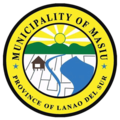Municipality in Lanao del Sur, Philippines
This article is about a municipality in modern-day Lanao del Sur. For "Pangampong a Masiu" or the State of Masiu, see
Confederate States of Lanao .
Municipality in Bangsamoro Autonomous Region in Muslim Mindanao, Philippines
Masiu
ماسيو
Municipality of Masiu Masiu municipal hall
Flag
Seal
Nickname: The True Heart of Mindanao
Map of Lanao del Sur with Masiu highlighted
Coordinates: 7°49′N 124°19′E / 7.82°N 124.32°E / 7.82; 124.32 Country Philippines Region Bangsamoro Autonomous Region in Muslim Mindanao Province Lanao del Sur District 1st district Barangays Barangays ) • Type Sangguniang Bayan • Mayor Romil M. Guiling • Vice Mayor Jadid R. Mimbantas • Representative Ziaur-Rahman A. Adiong • Municipal Council
Mojib M. Masbud Abduljabbar M. Mimbantas Moner G. Arimao Omar B. Arimao Hosney M. Oranggaga Alaynna G. Maca-alin H. Sobair P. Unda Domiangca G. Tomambiling • Electorate 17,664 voters (2025 ) • Total
170.00 km2 (65.64 sq mi) Elevation
769 m (2,523 ft) Highest elevation
1,125 m (3,691 ft) Lowest elevation
696 m (2,283 ft) • Total
33,580 • Density200/km2 (510/sq mi) • Households
4,963 • Income class 5th municipal income class • Poverty incidence % (2021) [ 4] • Revenue ₱ 155.7 million (2022) • Assets ₱ 78.02 million (2022) • Expenditure ₱ 152 million (2022) • Liabilities ₱ 18.01 million (2020), 0 million (2013, 2015, 2016, 2021), 12.52 million (2014), 2.91 million (2017, 2018), 28 million (2019) • ElectricityLanao del Sur Electric Cooperative (LASURECO) Time zone UTC+8 (PST ) ZIP code 9706
PSGC IDD area code +63 (0)63 Native languages Maranao Website www
Masiu , officially the Municipality of Masiu (Maranao : Inged a Masiu ; Tagalog : Bayan ng Masiu municipality in the province of Lanao del Sur , Philippines . According to the 2020 census, it has a population of 33,580 people. [ 3]
Geography Masiu is located due south of Marawi and is considered to be the geographic center of mainland Mindanao, with the extreme points located in Surigao City (north), Jose Abad Santos, Davao Occidental (south), Caraga, Davao Oriental (east) and Zamboanga City (west) respectively.
Barangays Masiu is politically subdivided into 35 barangays . Each barangay consists of puroks while some have sitios .
Abdullah Buisan Alim Raya Caramian Alip Lalabuan Sarip Batua Alumpang Paino Mimbalay Amai Ditimbang Balindong Amai Sindaolan Dansalan Buadiamaloy Buntalis Maranat Casim Lumbacaingud Dalog Balut Gindolongan Alabat Gondarangin Asa Adigao Labay Moriatao-Bai Laila Lumbac Bangon Lakadun Langco Dimapatoy Langi Talub Lomigis Sugod Maca-alin Lumbacaingud Macabangun Imbaba Macadaag Talaguian (Sultan Panimbang) Macalupang Lumbac Caramian Magayo Bagoaingud Magompara Apa Mimbalay Manalocon Talub Mangondato Kalilangan Marandacan Putad Matao Araza Mohammad Tangul Pangandaman Pantao Sambowang Atawa Sawir Tamboro Cormatan Tomambiling Lumbacaingud Towano Arangca Unda Dayawan Climate Climate data for Masiu, Lanao del Sur Month Jan Feb Mar Apr May Jun Jul Aug Sep Oct Nov Dec Year Mean daily maximum °C (°F) 26 26 26 27 26 25 25 25 25 25 25 26 26 Mean daily minimum °C (°F) 20 20 20 21 21 21 20 20 20 20 21 20 20 Average precipitation mm (inches) 236 225 244 235 304 287 200 175 158 200 287 243 2,794 Average rainy days 24.3 22.3 26.0 27.2 28.3 27.2 25.8 24.8 22.2 25.4 27.2 25.8 306.5 Source: Meteoblue (modeled/calculated data, not measured locally) [ 5]
This page is based on this
Wikipedia article Text is available under the
CC BY-SA 4.0 license; additional terms may apply.
Images, videos and audio are available under their respective licenses.





